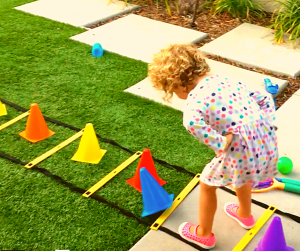Having access to equipment while coaching or training kids lends not only to variety, but to our ability as coaches to modify activities to make them more level-appropriate and/or engaging.
That being said, many youth coaches and teachers have been thrust into the virtual world nearly overnight, forced to figure out ways to keep kids engaged through the very screens they’ve considered the “enemy” to physical activity. While in-person teaching and training relies on standard space and equipment, this isn’t a luxury afforded by virtual training.
It’s a challenge to create a “standard” program when not all participants have access to standard equipment and training space.
Fortunately, there is nothing magic about cones, bean bags, agility ladders, and other forms of training equipment. These are all great options that can serve an important function, but when not available, other common items nearly all families have in their home can provide the variety and adaptability needed to help kids improve their physical skills.

To help kids and families transform everyday household items into functional and effective training equipment, the first step as a coach is to identify the skill(s) you need the equipment to help teach. For example, you want to teach kids directional movement and body control, so cones are great markers to establish a multidirectional pathway. BUT, do these markers have to be cones?
Actually, no.
Literally anything that is relatively light, small, and can be moved around easily can be used to mark a pathway. What light, small, and easily moveable items do nearly all families have around the house?
With this thought process, it becomes easier to identify common household items that can used as training equipment to increase the effectiveness and engagement with your virtual youth program.
Consider the common equipment uses and household items below and how these could be used during your programs.
Barriers
Barriers are objects that athletes have to move over, under, around, or otherwise avoid contact with. Coaches use barriers for agility, foot contact, plyometric, reaction, and other similar drills.
For example, cones or hurdles are barriers when kids have to jump over them. The rungs on an agility ladder are barriers that must be stepped over.
Understanding the intention of barriers as training equipment, what household items could be used?
- Plastic cups
- Pillows
- Toilet paper rolls
- Rolled up socks
- Sidewalk chalk (outdoors): (Draw barriers on the ground children need to avoid)
- Rocks (outdoors)
Guides
Guides designate a pathway for athletes to move “to” and “from” or boundaries they must stay within. Coaches use guides for directional and agility drills in addition to establishing training space.
For example, in an agility drill where cones are organized in a “Z” shape to create a multidirectional movement pathway, they would be serving as a guide. Lines or cones on the ground could be used to establish the boundaries athletes must stay within during an activity.
Understanding the intention of guides, what common household items could be used?
- Plastic cups
- Toilet paper rolls
- Rolled up socks
- Sidewalk chalk (outdoors): (Draw pathways athletes have to move along)
- Rocks (outdoors)
Targets
Targets establish a specific destination for athletes to move their body or implements to or on. While guides establish a pathway, targets establish a destination. Coaches use targets to create accuracy criteria for locomotion and manipulative skills.
For example, a soccer goal serves as a target for kicking a ball. Dots on the ground can represent targets kids must jump and land on. Cones on the ground can be targets for throwing bean bags.
Understanding the intention of targets, what common household items could be used?
- Plastic cups
- Paper plates or pieces of paper
- Plastic bowls
- Sidewalk chalk (outdoors): (Draw targets that athletes have to move their body or an implement to/on)
Implements
Implements are pieces of equipment that are manipulated in some way to throw, kick, catch, push, pull, lift, carry, or otherwise move. Coaches use implements to practice/teach manipulative skills, specific athletic activities, or to increase the difficulty of a movement (i.e. dumbbells).
For example, holding or throwing a medicine ball makes it an implement. A sled is an implement that can be pushed or pulled. Bean bags are implements that can be thrown and caught.
Understanding the intention of implements, what common household items could be used?
- Backpack with books in it: (Lift, carry, push, pull, chop)
- Rolled up socks: (Throw, catch, volley)
- Balloons: (Strike, catch, kick, volley)
- Pillows: (Throw, catch, slam, stand on for balance)
- Stationary objects (Wall, door, etc.): (Push, support)
Obviously, equipment can be used for multiple purposes in an activity. For example, circles drawn on the ground in sidewalk chalk can serve simultaneously as targets and guides for an activity.
The ideas provided above are hardly a complete list of what the kids you work with may have available at home. Consider the equipment you have used outside of virtual training and what it has helped accomplish. Provide parents with a short list of household items that can create the same outcome.
Below is a list we have used for our PE in Your Living Room Facebook live classes:
- 4 Cones or plastic cups
- 2 Bean bags or rolled up socks
- 2 pillows that kids can stand on
- 2 Paper plates or pieces of paper
- A blown-up balloon
These simple, common pieces of equipment have provided nearly endless options for different activities.

Don’t let the implied limitations of virtual training get in your way of inspiring kids to become active and athletic for life!
If you’re a member of the Powerful Playground, you have access to a recent online workshop we created to help you use common household items to add challenge and variety to your virtual training programs. Log in HERE to check it out.
If you’re not a member of the Powerful Playground, learn more HERE about how you can access an easily searchable database of unique activities that will make teaching important skills to your young athletes fast, fun and easy!
Brett Klika CEO and co-founder of SPIDERfit is an international award- winning certified strength and conditioning coach, author, and motivational speaker with over 20 years experience motivating and inspiring youngsters to a life of health, fitness, and performance.
Brett consults with schools, athletic organizations, fitness professionals, and fortune 500 companies around the world.




Thanks Coach Brett – all of these ideas are very helpful!
We are constantly looking for new ways like these to engage kids and teach skills in our online and outdoor classes, as well as helping Moms and Dads with movement ideas for family P.E.
We are very grateful to have such a dedicated, creative coach available to all of us who are coaching kids!